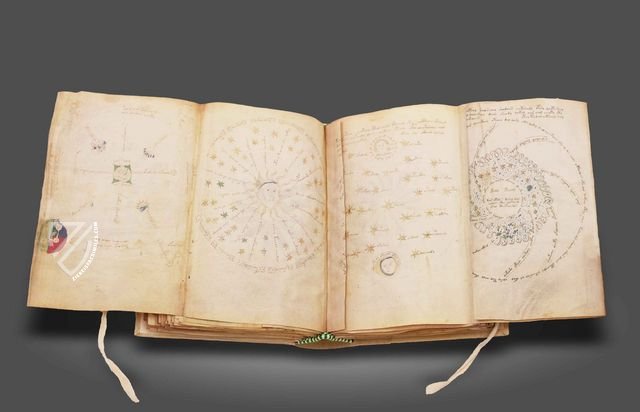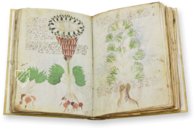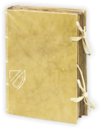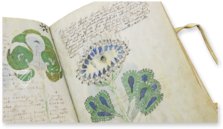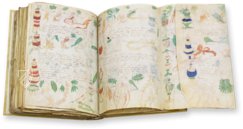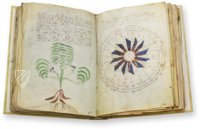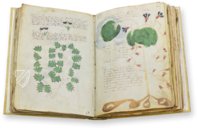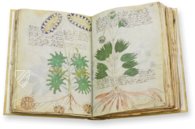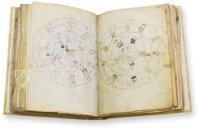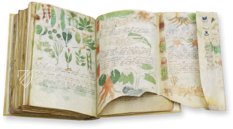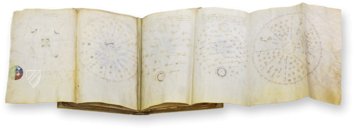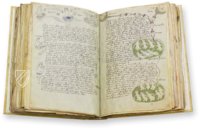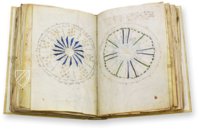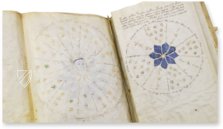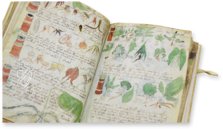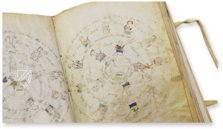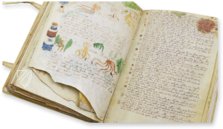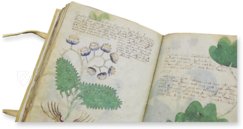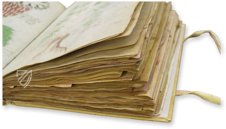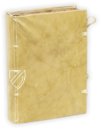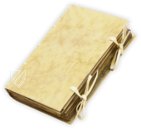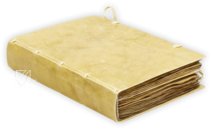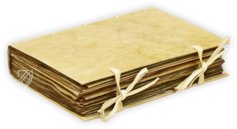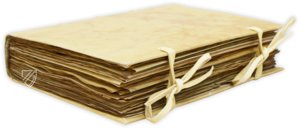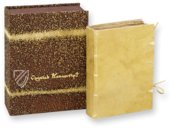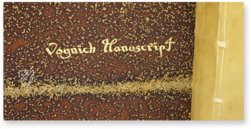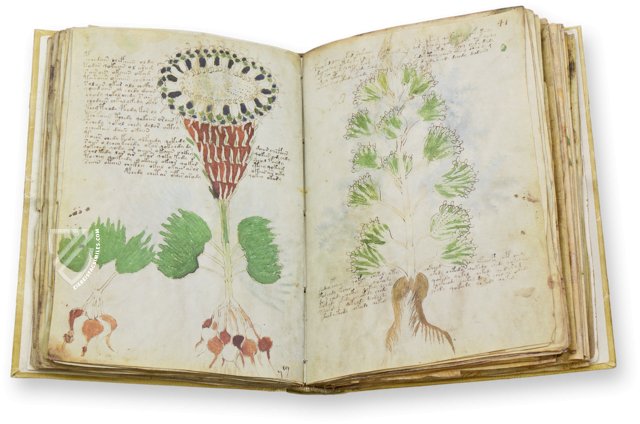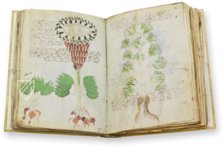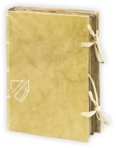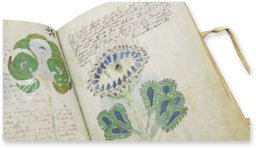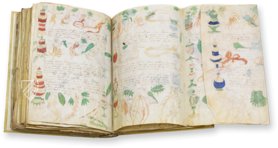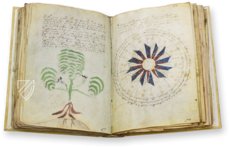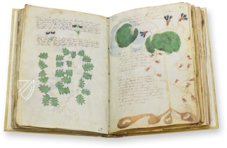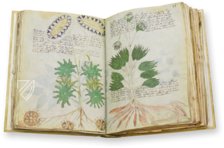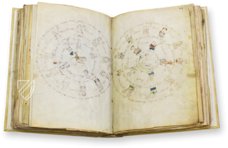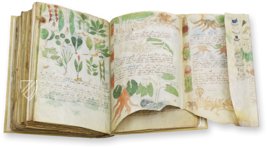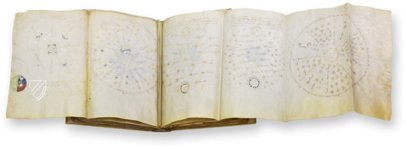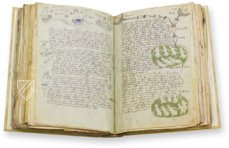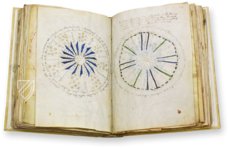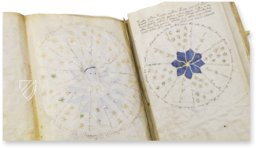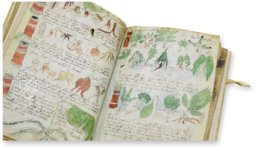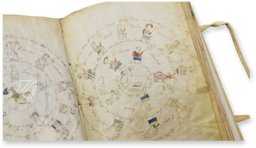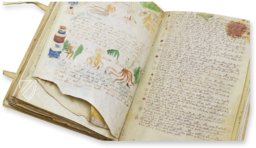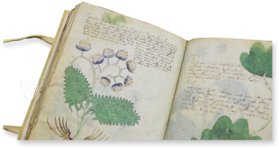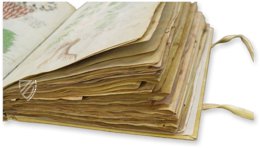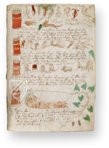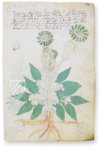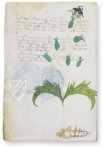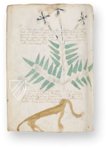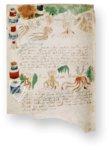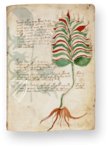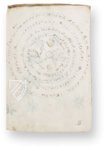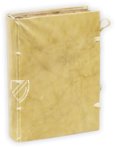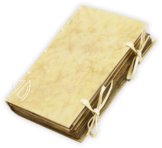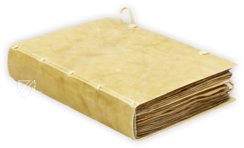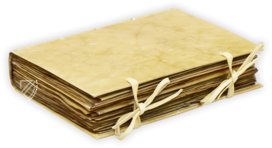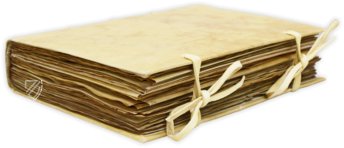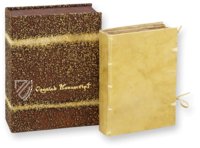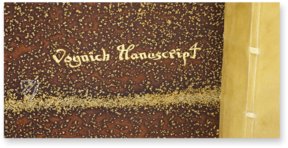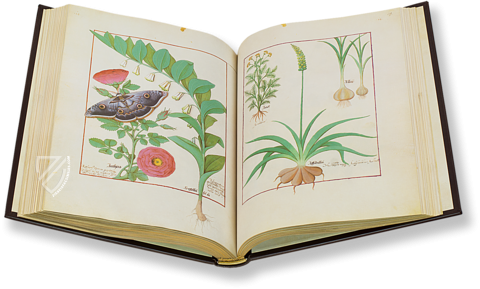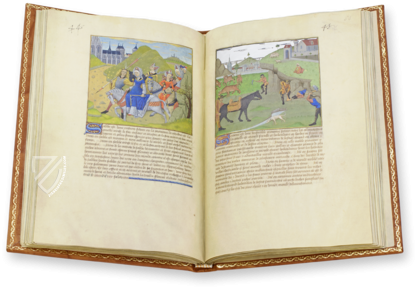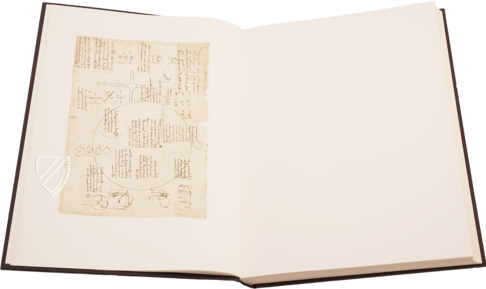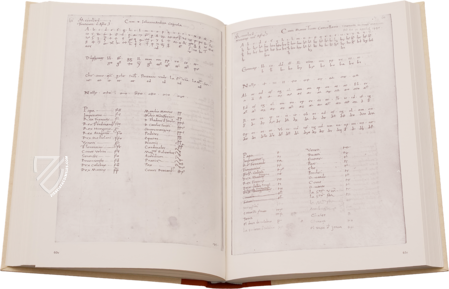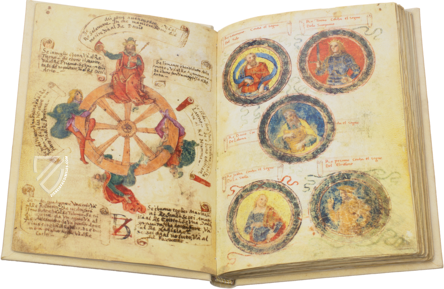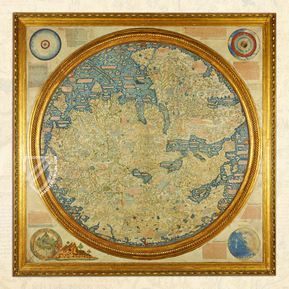Voynich Manuscript
(7,000€ - 10,000€)
The document at Yale University that has become known as the Voynich Manuscript is without question the most mysterious and enigmatic manuscript in the history of illumination. It is a work of the 15th or early 16th century and collects wonderfully figurative and floral illustrations with text recorded in cryptic cypher on its 204 pages. Numerous famous names are associated with the history of the Voynich Manuscript, and the riddle and the deciphering of the mysterious text – simultaneously its own science – occupies numerous researchers and enthusiasts to this day. The pharmaceutical, botanical, cosmographic, astrological, or otherwise-oriented Voynich Manuscript is one of the greatest historical mysteries of all time.
Voynich Manuscript
The document that has become known as the Voynich Manuscript of Yale University is without question the most mysterious and enigmatic manuscript in the history of illumination. It is a work of the early 15th or early 16th century and collects wonderfully figurative and floral illustrations with text recorded in cryptic cypher on its 204 pages. Numerous famous names are associated with the history of the Voynich Manuscript, and the riddle and the deciphering of the mysterious text – simultaneously its own science – occupies numerous researchers and enthusiasts to this day. The pharmaceutical, botanical, cosmographic, astrological, or otherwise-oriented Voynich Manuscript is one of the greatest historical mysteries of all time!
To the Scholars via the Emperor
The manuscript, which was presumably made in the 15th or beginning of the 16th century in central Europe (probably in France, Spain, or Italy), and boasts a diverse provenance. The Voynich Manuscript was in the possession of Kaiser Rudolph II von Habsburg (1576–1612), who had his (Bohemian) court pharmacist Jacobus Horcicky de Tepenecz (d. 1622) research it. The name of the English astrologer John Dee (1527–1608) is also associated with the manuscript. The mysterious manuscript reached came into the collection of Johannes Marcus Marci von Landskron (1595–1667) und Georg Baresch. The latter finally gathered the council of the famous Renaissance Man Athanasius Kircher (1601–1680), who is supposed to have occupied himself with the decryption of the mystery. After Kircher, the Voynich Manuscript presumably reached various libraries in Rome and Italy over the course of two centuries, and was rediscovered by Wilfred M. Voynich (1865–1930) in the year 1912 at the Villa Mondragone in Frascati. Voynich endowed the manuscript, which is named after him today, to Yale University in 1969.
Mysterious Scenes and Large-Format Botanical Depictions
All of these historical personalities were fascinated by an exceptional manuscript from the 15th or 16th century. This dating is the result of the classification of the script and of the material according to the C–14 method. Magnificently colored, large-format drawings illustrate all of the pages of the manuscript. These present depictions of plants, from their roots in the soil up to their flowers and fruits, but also enigmatic, figurative representations and mysterious diagrams. The illustrations have a fantastical-botanical appearance. So is this manuscript a botanical work? A work of minerology or astrology? Of pharmacy or cosmology? Of the esoteric and magical? Or is it something completely different?
What Secrets Hide between the Book’s Covers?
The text, which is artfully draped about the drawings, could give information about the placement of the scientific treatise. However, this is recorded in an enigmatic language, in cryptic cypher. Are we admiring the work of a universal genius? Presumably, several clever heads were involved with the manuscript. A letter written by Johannes Marcus Marci to Athanasius Kircher in 1665 or 1666 speculates that Roger Bacon, the important 13th century English philosopher and academic, is the author of the manuscript, and Voynich shared this hypothesis. In any case, the decryption of the riddle has occupied and fascinated countless researchers and enthusiasts over the years and centuries. Numerous (conspiracy) theories wind themselves around this unique manuscript. It has been continuously asserted that the mystery will be decoded. Yet is that really the case? The riddle remains unsolved to this day…
Codicology
- Alternative Titles
- Voynich-Manuskript
Voynich Manuskript
Manuscrito Voynich
Manoscritto Voynich - Size / Format
- 204 pages / 22.5 × 16.0 cm
- Origin
- Italy
- Date
- End of 15th century or during the 16th century
- Epochs
- Style
- Script
- Based on Roman minuscule
- Illustrations
- Nearly every pages of the manuscript contains scientific or botanic drawing, partly with human figures. Written and drawn in ink and various colors (red, green, blue, yellow).
- Content
- Scientific or magical text in an unidentified language, in cipher
- Artist / School
- Maybe Roger Bacon
- Previous Owners
- Emperor Rudolph II of Germany (1576–1612)
John Dee (English astrologer, 1527–1608)
Jacobus Horcicky de Tepenecz (d. 1622)
Johannes Marcus Marci of Cronland (1595–1667)
Athanasius Kircher (1601–1680)
Wilfred M. Voynich (1865–1930)
H. P. Kraus
Voynich Manuscript
Pharmaceutical Section
Various herbs, roots, and other efficacious ingredients used for creating medicines are shown here alongside a red bowl or mortar in which they will be ground together. Of course, this is only a guess: this page like the rest of the work remains undeciphered to this day despite the efforts of countless codebreakers. Nonetheless, the ingredients appear to be labelled individually and it is difficult to imagine a metaphorical or allegorical use for such a specific-looking text.
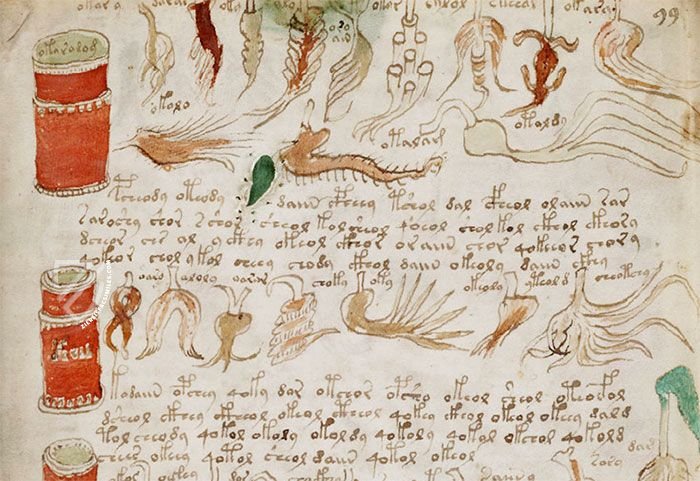
Voynich Manuscript
A Sunflower (?)
Sprawling from one edge of the page to the other, this botanical miniature is just one of hundreds in this enigmatic manuscript. It has been theorized that it could be intended to be a depiction of a sunflower from the New World. This remains only a theory, unfortunately, because if it were proven true then that would point to precious clues with respect to the manuscript’s origins.
The blue pedals depicted on this page should immediately stick out to the modern observer who is even casually familiar with sunflowers. While special varieties have certainly been created with all kinds of colors, this color in combination with the pseudo-tropical looking leaves and odd, spikey roots balls leaves even the most imaginative botanist scratching their head.
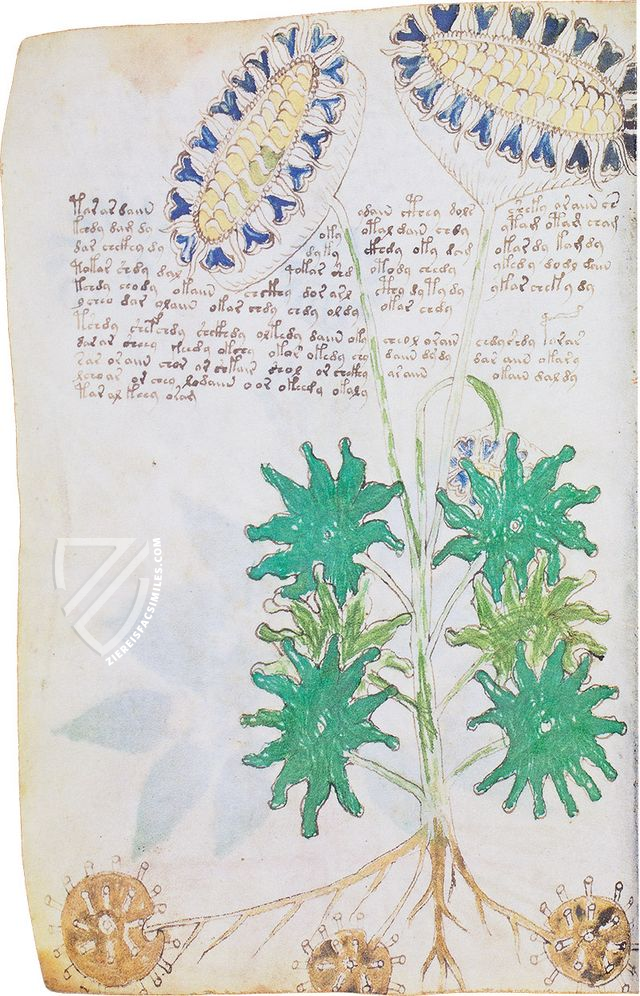
#1 Voynich-Manuskript
Language: English
(7,000€ - 10,000€)
- Treatises / Secular Books
- Apocalypses / Beatus
- Astronomy / Astrology
- Bestiaries
- Bibles / Gospels
- Chronicles / History / Law
- Geography / Maps
- Saints' Lives
- Islam / Oriental
- Judaism / Hebrew
- Single Leaf Collections
- Leonardo da Vinci
- Literature / Poetry
- Liturgical Manuscripts
- Medicine / Botany / Alchemy
- Music
- Mythology / Prophecies
- Psalters
- Other Religious Books
- Games / Hunting
- Private Devotion Books
- Other Genres
- Afghanistan
- Armenia
- Austria
- Belgium
- Belize
- Bosnia and Herzegovina
- China
- Colombia
- Costa Rica
- Croatia
- Cyprus
- Czech Republic
- Denmark
- Egypt
- El Salvador
- Ethiopia
- France
- Germany
- Greece
- Guatemala
- Honduras
- Hungary
- India
- Iran
- Iraq
- Israel
- Italy
- Japan
- Jordan
- Kazakhstan
- Kyrgyzstan
- Lebanon
- Liechtenstein
- Luxembourg
- Mexico
- Morocco
- Netherlands
- Palestine
- Panama
- Peru
- Poland
- Portugal
- Romania
- Russia
- Serbia
- Spain
- Sri Lanka
- Sweden
- Switzerland
- Syria
- Tajikistan
- Turkey
- Turkmenistan
- Ukraine
- United Kingdom
- United States
- Uzbekistan
- Vatican City
- A. Oosthoek, van Holkema & Warendorf
- Aboca Museum
- Ajuntament de Valencia
- Akademie Verlag
- Akademische Druck- u. Verlagsanstalt (ADEVA)
- Aldo Ausilio Editore - Bottega d’Erasmo
- Alecto Historical Editions
- Alkuin Verlag
- Almqvist & Wiksell
- Amilcare Pizzi
- Andreas & Andreas Verlagsbuchhandlung
- Archa 90
- Archiv Verlag
- Archivi Edizioni
- Arnold Verlag
- ARS
- Ars Magna
- ArtCodex
- AyN Ediciones
- Azimuth Editions
- Badenia Verlag
- Bärenreiter-Verlag
- Belser Verlag
- Belser Verlag / WK Wertkontor
- Benziger Verlag
- Bernardinum Wydawnictwo
- BiblioGemma
- Biblioteca Apostolica Vaticana (Vaticanstadt, Vaticanstadt)
- Bibliotheca Palatina Faksimile Verlag
- Bibliotheca Rara
- Boydell & Brewer
- Bramante Edizioni
- Bredius Genootschap
- Brepols Publishers
- British Library
- C. Weckesser
- Caixa Catalunya
- Canesi
- CAPSA, Ars Scriptoria
- Caratzas Brothers, Publishers
- Carus Verlag
- Casamassima Libri
- Centrum Cartographie Verlag GmbH
- Chavane Verlag
- Christian Brandstätter Verlag
- Circulo Cientifico
- Club Bibliófilo Versol
- Club du Livre
- CM Editores
- Collegium Graphicum
- Collezione Apocrifa Da Vinci
- Comissão Nacional para as Comemorações dos Descobrimentos Portugueses
- Coron Verlag
- Corvina
- CTHS
- D. S. Brewer
- Damon
- De Agostini/UTET
- De Nederlandsche Boekhandel
- De Schutter
- Deuschle & Stemmle
- Deutscher Verlag für Kunstwissenschaft
- DIAMM
- Droz
- E. Schreiber Graphische Kunstanstalten
- Ediciones Boreal
- Ediciones Grial
- Ediclube
- Edições Inapa
- Edilan
- Editalia
- Edition Deuschle
- Edition Georg Popp
- Edition Leipzig
- Edition Libri Illustri
- Editiones Reales Sitios S. L.
- Éditions de l'Oiseau Lyre
- Editions Medicina Rara
- Editorial Casariego
- Editorial Mintzoa
- Editrice Antenore
- Editrice Velar
- Edizioni Edison
- Egeria, S.L.
- Eikon Editores
- Electa
- Emery Walker Limited
- Enciclopèdia Catalana
- Eos-Verlag
- Ephesus Publishing
- Ernst Battenberg
- Eugrammia Press
- Extraordinary Editions
- Fackelverlag
- Facsimila Art & Edition
- Facsimile Editions Ltd.
- Facsimilia Art & Edition Ebert KG
- Faksimile Verlag
- Feuermann Verlag
- Folger Shakespeare Library
- Franco Cosimo Panini Editore
- Friedrich Wittig Verlag
- Fundación Hullera Vasco-Leonesa
- G. Braziller
- Gabriele Mazzotta Editore
- Gebr. Mann Verlag
- Gesellschaft für graphische Industrie
- Getty Research Institute
- Giovanni Domenico de Rossi
- Giunti Editore
- Graffiti
- Grafica European Center of Fine Arts
- Guido Pressler
- Guillermo Blazquez
- Gustav Kiepenheuer
- H. N. Abrams
- Harrassowitz
- Harvard University Press
- Helikon
- Hendrickson Publishers
- Henning Oppermann
- Herder Verlag
- Hes & De Graaf Publishers
- Hoepli
- Holbein-Verlag
- Houghton Library
- Hugo Schmidt Verlag
- Idion Verlag
- Il Bulino, edizioni d'arte
- ILte
- Imago
- Insel Verlag
- Insel-Verlag Anton Kippenberger
- Instituto de Estudios Altoaragoneses
- Instituto Nacional de Antropología e Historia
- Introligatornia Budnik Jerzy
- Istituto dell'Enciclopedia Italiana - Treccani
- Istituto Ellenico di Studi Bizantini e Postbizantini
- Istituto Geografico De Agostini
- Istituto Poligrafico e Zecca dello Stato
- Italarte Art Establishments
- Jan Thorbecke Verlag
- Johnson Reprint Corporation
- Josef Stocker
- Josef Stocker-Schmid
- Jugoslavija
- Karl W. Hiersemann
- Kasper Straube
- Kaydeda Ediciones
- Kindler Verlag / Coron Verlag
- Kodansha International Ltd.
- Konrad Kölbl Verlag
- Kurt Wolff Verlag
- La Liberia dello Stato
- La Linea Editrice
- La Meta Editore
- Lambert Schneider
- Landeskreditbank Baden-Württemberg
- Leo S. Olschki
- Les Incunables
- Liber Artis
- Library of Congress
- Libreria Musicale Italiana
- Lichtdruck
- Lito Immagine Editore
- Lumen Artis
- Lund Humphries
- M. Moleiro Editor
- Maison des Sciences de l'homme et de la société de Poitiers
- Manuscriptum
- Martinus Nijhoff
- Maruzen-Yushodo Co. Ltd.
- MASA
- Massada Publishers
- McGraw-Hill
- Metropolitan Museum of Art
- Militos
- Millennium Liber
- Müller & Schindler
- Nahar - Stavit
- Nahar and Steimatzky
- National Library of Wales
- Neri Pozza
- Nova Charta
- Oceanum Verlag
- Odeon
- Orbis Mediaevalis
- Orbis Pictus
- Österreichische Staatsdruckerei
- Oxford University Press
- Pageant Books
- Parzellers Buchverlag
- Patrimonio Ediciones
- Pattloch Verlag
- PIAF
- Pieper Verlag
- Plon-Nourrit et cie
- Poligrafiche Bolis
- Presses Universitaires de Strasbourg
- Prestel Verlag
- Princeton University Press
- Prisma Verlag
- Priuli & Verlucca, editori
- Pro Sport Verlag
- Propyläen Verlag
- Pytheas Books
- Quaternio Verlag Luzern
- Reales Sitios
- Recht-Verlag
- Reichert Verlag
- Reichsdruckerei
- Reprint Verlag
- Riehn & Reusch
- Roberto Vattori Editore
- Rosenkilde and Bagger
- Roxburghe Club
- Salerno Editrice
- Saltellus Press
- Sandoz
- Sarajevo Svjetlost
- Schöck ArtPrint Kft.
- Schulsinger Brothers
- Scolar Press
- Scrinium
- Scripta Maneant
- Scriptorium
- Shazar
- Siloé, arte y bibliofilia
- SISMEL - Edizioni del Galluzzo
- Sociedad Mexicana de Antropología
- Société des Bibliophiles & Iconophiles de Belgique
- Soncin Publishing
- Sorli Ediciones
- Stainer and Bell
- Studer
- Styria Verlag
- Sumptibus Pragopress
- Szegedi Tudomànyegyetem
- Taberna Libraria
- Tarshish Books
- Taschen
- Tempus Libri
- Testimonio Compañía Editorial
- Thames and Hudson
- The Clear Vue Publishing Partnership Limited
- The Facsimile Codex
- The Folio Society
- The Marquess of Normanby
- The Richard III and Yorkist History Trust
- Tip.Le.Co
- TouchArt
- TREC Publishing House
- TRI Publishing Co.
- Trident Editore
- Tuliba Collection
- Typis Regiae Officinae Polygraphicae
- Union Verlag Berlin
- Universidad de Granada
- University of California Press
- University of Chicago Press
- Urs Graf
- Vallecchi
- Van Wijnen
- VCH, Acta Humaniora
- VDI Verlag
- VEB Deutscher Verlag für Musik
- Verlag Anton Pustet / Andreas Verlag
- Verlag Bibliophile Drucke Josef Stocker
- Verlag der Münchner Drucke
- Verlag für Regionalgeschichte
- Verlag Styria
- Vicent Garcia Editores
- W. Turnowski Ltd.
- W. Turnowsky
- Waanders Printers
- Wiener Mechitharisten-Congregation (Wien, Österreich)
- Wissenschaftliche Buchgesellschaft
- Wissenschaftliche Verlagsgesellschaft
- Wydawnictwo Dolnoslaskie
- Xuntanza Editorial
- Zakład Narodowy
- Zollikofer AG

